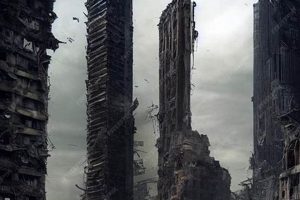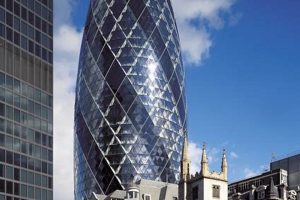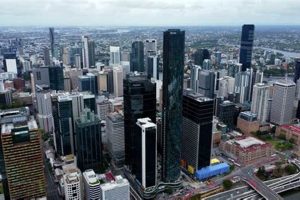A skyscraper is a continuously habitable high-rise building having multiple floors which are typically occupied for work or living purposes. Defining characteristics include being exceptionally tall, having a steel skeletal structure, and having multiple elevators. For most of history, the tallest structures were religious structures such as church steeples and towers, or secular constructions such as lighthouses. The first true skyscraper, the Home Insurance Building in Chicago, was built in 1885.
Skyscrapers provide several benefits over traditional low-rise buildings. They allow for more efficient use of land, as they can accommodate more people or businesses in a smaller area. They can also be more energy-efficient, as they can be designed to take advantage of natural light and ventilation. Additionally, skyscrapers can be iconic landmarks that define a city’s skyline and attract tourism.
The construction of skyscrapers has been made possible by a number of technological advancements, including the development of steel framing, elevators, and fireproofing materials. Skyscrapers have also been shaped by economic factors, such as the need for office space in dense urban areas. In recent years, there has been a trend towards building taller and taller skyscrapers, with some of the tallest buildings in the world now reaching over 1,000 feet tall.
1. Height
Height is a defining characteristic of skyscrapers, distinguishing them from traditional buildings and establishing their iconic status. Skyscrapers are designed to soar upwards, reaching heights that were previously unattainable, challenging the limits of architectural engineering.
This vertical growth has been enabled by the use of steel frameworks, which provide exceptional strength and support. These frameworks allow skyscrapers to withstand the immense weight and forces exerted by their own height, as well as external factors like wind and seismic activity. The incorporation of multiple elevators is also crucial, facilitating efficient vertical transportation for occupants and visitors.
The pursuit of height in skyscrapers has practical implications. It allows for more efficient use of land, especially in densely populated urban areas. By building upwards, skyscrapers can accommodate a large number of people or businesses within a relatively small footprint. This vertical expansion also creates opportunities for diverse uses within a single structure, such as residential units, office spaces, retail stores, and recreational facilities.
Furthermore, the height of skyscrapers has a significant impact on urban skylines, often becoming landmarks that define a city’s identity. These architectural marvels attract tourism and contribute to the overall economic development of the area. They serve as symbols of progress, innovation, and architectural prowess.
Understanding the connection between height and the definition of a skyscraper is essential for appreciating the unique characteristics and significance of these structures in the realm of architecture and urban planning.
2. Steel Structure
Steel structure is a crucial component in the definition of a skyscraper, enabling these architectural marvels to reach unprecedented heights and withstand the forces exerted by their own weight and external factors. The use of steel frameworks provides exceptional strength and support, allowing skyscrapers to soar upwards and become symbols of progress and innovation.
The traditional use of masonry and concrete in building construction had limitations in height due to their compressive strength and weight. Steel, with its high tensile strength and relatively light weight, revolutionized skyscraper construction. Steel frameworks distribute the weight of the building more efficiently, allowing for taller and more slender structures.
The Empire State Building, one of the most iconic skyscrapers in the world, exemplifies the importance of steel structure. Completed in 1931, it stands at 102 stories and 1,250 feet tall. Its steel framework, composed of over 60,000 tons of steel, provides the necessary strength and support to withstand wind loads, seismic activity, and the weight of its occupants and contents.
Understanding the connection between steel structure and the definition of a skyscraper is essential for appreciating the engineering prowess and architectural significance of these structures. Steel frameworks have enabled the construction of taller, stronger, and more resilient skyscrapers, shaping skylines and transforming cities worldwide.
3. Multiple Floors
The incorporation of multiple floors is a defining characteristic of skyscrapers, enabling them to accommodate a wide range of uses and functions within a single structure. These vertically stacked levels are essential for maximizing space utilization, creating diverse and dynamic environments, and enhancing the overall functionality of skyscrapers.
Skyscrapers, by virtue of their height, provide ample opportunities for vertical zoning, allowing for the segregation of different activities and uses. This vertical organization is crucial for accommodating the complex needs of modern urban life. For instance, the lower floors of a skyscraper can be dedicated to retail and commercial spaces, while the middle floors can house offices and business centers. The upper floors, often offering panoramic views, are often reserved for residential units or luxury amenities such as rooftop gardens and observation decks.
The practical significance of multiple floors in skyscrapers extends beyond space utilization. It also allows for the creation of mixed-use developments that combine residential, commercial, and recreational spaces within a single building. This integration promotes walkability, reduces commuting times, and fosters a vibrant urban environment. Mixed-use skyscrapers are becoming increasingly popular in densely populated cities, where land is scarce and the demand for diverse urban spaces is high.
Understanding the connection between multiple floors and the definition of a skyscraper is essential for appreciating the versatility and functionality of these architectural marvels. Multiple floors enable skyscrapers to adapt to the evolving needs of modern society, providing flexible and dynamic spaces that enhance urban living and contribute to the overall economic and social vitality of cities.
4. Elevators
Within the definition of a skyscraper, elevators play a pivotal
role in enabling efficient vertical transportation, addressing the challenges posed by extreme height and ensuring the accessibility and functionality of these architectural marvels.
- Overcoming Vertical Challenges:
Skyscrapers, with their towering heights, present a unique challenge for vertical movement. Elevators provide a practical and efficient solution, allowing occupants to navigate between floors quickly and conveniently. They eliminate the physical strain and time constraints associated with climbing stairs, making high-rise living and working spaces accessible to all.
- Maximizing Space Utilization:
In skyscrapers, vertical space is a valuable commodity. Elevators optimize space utilization by eliminating the need for expansive stairwells, freeing up precious floor space for other uses. This efficient use of space contributes to the overall functionality and economic viability of skyscrapers.
- Enhanced Accessibility and Inclusivity:
Elevators promote accessibility and inclusivity in skyscrapers. They enable individuals with physical limitations or carrying heavy loads to navigate the building with ease, ensuring equal access to all levels. This inclusive approach aligns with the principles of universal design and caters to the diverse needs of modern society.
- Fire Safety and Emergency Response:
In the event of a fire or other emergency, elevators serve as crucial evacuation routes, allowing occupants to descend quickly and safely. Firefighter access is also facilitated through elevators, enabling them to reach higher floors efficiently and respond effectively to emergencies.
The integration of elevators is inextricably linked to the definition of a skyscraper, enabling these architectural wonders to function seamlessly and fulfill their intended purpose. Elevators are not merely components but essential elements that contribute to the accessibility, functionality, and safety of skyscrapers.
5. Urban Density
Skyscrapers play a crucial role in addressing the challenges of urban density, particularly in crowded cities where land is scarce and expensive. By allowing for efficient land use, skyscrapers contribute to sustainable urban development and enhance the quality of life for urban dwellers.
- Maximizing Vertical Space:
Skyscrapers utilize vertical space effectively, allowing for a greater number of people and businesses to be accommodated within a limited footprint. This vertical expansion reduces urban sprawl and preserves valuable land resources for other purposes, such as parks, green spaces, and infrastructure.
- Mixed-Use Developments:
Skyscrapers often incorporate mixed-use developments, combining residential, commercial, and recreational spaces within a single building. This integration promotes walkability, reduces commuting times, and encourages a vibrant urban lifestyle. By consolidating diverse functions into one structure, skyscrapers optimize land use and create more livable and sustainable urban environments.
- Reduced Infrastructure Costs:
Concentrating a large population within a skyscraper reduces the need for extensive infrastructure networks, such as roads, utilities, and public transportation. This consolidation leads to cost savings and increased efficiency in the provision of urban services.
- Environmental Benefits:
Skyscrapers can contribute to environmental sustainability by reducing urban heat island effects and promoting energy efficiency. Their height allows for better air circulation and natural light penetration, reducing the need for artificial lighting and cooling systems. Additionally, mixed-use developments encourage walking and cycling, which further reduces traffic congestion and air pollution.
In conclusion, the connection between urban density and the definition of a skyscraper highlights the role of these architectural marvels in addressing the challenges of crowded cities. By allowing for efficient land use, skyscrapers contribute to sustainable urban development, enhance the quality of life for urban dwellers, and promote a more livable and environmentally conscious urban environment.
6. Architectural Icons
Skyscrapers, with their towering heights and striking designs, often transcend their functional purpose and become iconic landmarks that embody the identity and aspirations of the cities they inhabit. This symbolic significance is deeply intertwined with the definition of a skyscraper and contributes to its cultural and historical relevance.
- Symbols of Urban Identity:
Skyscrapers have become synonymous with major cities worldwide, serving as instantly recognizable symbols that define their skylines. The Empire State Building in New York City, the Petronas Towers in Kuala Lumpur, and the Burj Khalifa in Dubai are just a few examples of skyscrapers that have become iconic representations of their respective cities.
- Expressions of Cultural and Technological Progress:
Skyscrapers embody the spirit of innovation and technological advancement. They showcase the latest architectural techniques, engineering feats, and sustainable design principles. By pushing the boundaries of construction and design, skyscrapers serve as testaments to human ingenuity and progress.
- Economic and Cultural Hubs:
Skyscrapers often serve as central hubs for business, finance, and cultural activities. They house corporate headquarters, financial institutions, and cultural venues, attracting a diverse mix of people from all walks of life. This concentration of activity contributes to the economic and cultural vitality of the surrounding urban environment.
- Inspirational and Aspirational:
The sheer scale and grandeur of skyscrapers can inspire awe and aspiration. They represent the limitless possibilities of human ambition and serve as symbols of hope and prosperity. By reaching for the sky, skyscrapers embody the human desire to achieve great heights and leave a lasting legacy.
In conclusion, the connection between architectural icons and the definition of a skyscraper highlights the cultural, historical, and symbolic significance of these architectural marvels. Skyscrapers are not merely functional structures but also powerful symbols that reflect the identity, progress, and aspirations of the cities they call home.
7. Engineering Challenges
The pursuit of constructing skyscrapers has always been accompanied by a series of engineering challenges, necessitating innovative solutions and pushing the boundaries of structural design. These challenges are deeply intertwined with the definition of a skyscraper, shaping its form, function, and overall significance.
- Vertical Loads and Wind Resistance:
Skyscrapers must withstand immense vertical loads due to their own weight and the weight of their occupants and contents. Additionally, they must resist lateral forces caused by wind, which can cause swaying and instability. Engi
neers employ various techniques to address these challenges, including reinforced concrete core structures, exterior bracing systems, and tuned mass dampers. - Foundation and Soil Conditions:
The foundation of a skyscraper must be able to support its massive weight and distribute the load evenly across the underlying soil. Engineers conduct thorough soil analysis and employ specialized foundation systems, such as deep pile foundations or reinforced concrete mats, to ensure stability and prevent settling.
- Fire Safety and Evacuation:
Skyscrapers pose unique fire safety challenges due to their height and the large number of occupants. Engineers incorporate fire-resistant materials, compartmentalization, and advanced fire suppression systems to minimize the risk of fire spread and facilitate safe evacuation.
- Sustainability and Energy Efficiency:
Modern skyscrapers are designed with a focus on sustainability and energy efficiency. Engineers employ innovative building materials, energy-efficient systems, and renewable energy sources to reduce the environmental impact and operating costs of these high-rise structures.
In conclusion, the engineering challenges associated with skyscrapers have played a pivotal role in shaping their definition and evolution. By overcoming these challenges through innovative structural design solutions, engineers have enabled the construction of these architectural marvels that dominate skylines worldwide.
8. Economic Drivers
The economic impact of skyscrapers is a crucial aspect of their definition, as these architectural marvels serve as catalysts for urban development and investment. The construction and presence of skyscrapers have a ripple effect that positively impacts the surrounding area and the city as a whole.
Skyscrapers attract businesses and industries, leading to job creation and economic growth. They provide ample office space for corporations, financial institutions, and other enterprises, fostering a vibrant business environment. The concentration of economic activities in skyscrapers creates a synergy that drives innovation, collaboration, and economic prosperity.
Additionally, skyscrapers stimulate real estate development and investment. The presence of iconic skyscrapers in a city attracts investors and developers, leading to the construction of new residential, commercial, and retail spaces. This increased investment in the surrounding area contributes to urban renewal, job creation, and overall economic growth.
Furthermore, skyscrapers often serve as landmarks and tourist attractions, drawing visitors from around the world. This influx of tourism generates revenue for the city, supports local businesses, and enhances the city’s global image.
In conclusion, the economic impact of skyscrapers is an integral part of their definition. Skyscrapers are not just architectural wonders; they are also powerful economic drivers that stimulate urban development, investment, and job creation, contributing to the overall prosperity and vitality of the cities they inhabit.
9. Sustainability
Sustainability has become an increasingly important aspect of modern skyscraper design, as these architectural marvels strive to minimize their environmental impact while providing comfortable and efficient living and working spaces. The incorporation of eco-friendly features is now an integral part of the definition of a skyscraper, reflecting the growing global awareness of the need for sustainable urban development.
Skyscrapers can significantly contribute to greenhouse gas emissions and energy consumption due to their sheer size and the high energy demands of their occupants. However, by adopting sustainable practices and incorporating eco-friendly features, architects and engineers can mitigate these environmental concerns and create buildings that are both iconic and environmentally responsible.
Some common sustainability features found in modern skyscrapers include:
- Energy-efficient lighting systems
- High-performance building envelopes
- Water-saving fixtures and appliances
- Renewable energy sources, such as solar and wind power
- Green roofs and vertical gardens
By implementing these and other sustainable measures, skyscrapers can reduce their carbon footprint, conserve natural resources, and create healthier indoor environments for occupants.
The Burj Khalifa in Dubai, the world’s tallest building, is a prime example of a skyscraper that incorporates sustainability into its design. The building features a double-skin facade that reduces heat gain and energy consumption, a rainwater harvesting system, and solar panels that generate a portion of the building’s electricity needs.
Incorporating sustainability into the definition of a skyscraper is not only about environmental responsibility but also about economic sense. Sustainable skyscrapers are more cost-effective to operate and maintain in the long run, as they consume less energy and water. Additionally, they attract tenants who are increasingly seeking out green and sustainable workspaces.
As the world continues to urbanize and the demand for high-rise buildings increases, the incorporation of eco-friendly features into skyscraper design will become even more critical. By embracing sustainability, architects and engineers can create skyscrapers that are not only architectural marvels but also beacons of environmental responsibility.
Frequently Asked Questions about Skyscrapers
Skyscrapers, with their towering heights and iconic designs, have shaped skylines and transformed cities worldwide. Here are answers to some commonly asked questions about these architectural marvels:
Question 1: What is the defining characteristic of a skyscraper?
Skyscrapers are defined by their exceptional height, typically exceeding 150 meters or 500 feet. They have a steel skeletal structure, multiple floors, and are equipped with elevators for vertical transportation.
Question 2: What was the first skyscraper?
The Home Insurance Building in Chicago, completed in 1885, is widely recognized as the first skyscraper. It stood at 10 stories tall and marked a significant turning point in architectural engineering.
Question 3: What are the benefits of building skyscrapers?
Skyscrapers offer several advantages, including efficient land use, reduced urban sprawl, and the creation of vertical communities. They can also serve as landmarks and tourist attractions, boosting economic development.
Question 4: How do skyscrapers withstand strong winds and earthquakes?
Skyscrapers employ various engineering techniques to resist lateral forces. These include reinforced concrete cores, exterior bracing systems, and tuned mass dampers, which help absorb and dissipate wind and seismic energy.
Question 5: Are skyscrapers energy-efficient?
Modern skyscrapers incorporate sustainable design principles to reduce energy consumption. They utilize energy-efficient lighting, high-performance building envelopes, and renewable energy sources, such as solar and wind power, to minimize their environmental impact.
Question 6: What is the tallest skyscraper in the world?
As of 2023, the Burj Khalifa in Dubai holds the title of the world’s tallest skyscraper, standing at an impressive 828 meters or 2,717 feet tall.
In summary, skyscrapers are architectural marvels that combine engineering prowess with functional and aesthetic considerations. Their impact extends beyond aesthetics, as they play a significant role in urban development, economic growth, and sustainable design.
Transition to the next article section:
Tips for Understanding Skyscrapers
Skyscrapers, with their towering heights and iconic designs, have become symbols of urban development and architectural prowess. Understanding the complexities of these architectural marvels requires a comprehensive approach. Here are a few tips to help you gain a deeper understanding of skyscrapers:
Tip 1: Study the Structural Design:
Skyscrapers are feats of engineering, and their structural design is crucial to their stability and resilience. Familiarize yourself with the concepts of steel skeletal structures, reinforced concrete cores, and exterior bracing systems. Understand how these elements work together to withstand vertical loads, lateral forces, and seismic activity.
Tip 2: Explore the Historical Context:
The evolution of skyscrapers is intertwined with technological advancements and urban planning. Trace the historical development of skyscrapers from their origins in the late 19th century to modern-day sustainable designs. Learn about the architects and engineers who pushed the boundaries of architectural possibilities.
Tip 3: Analyze the Functional Aspects:
Skyscrapers are not merely tall buildings; they are complex ecosystems that house a variety of functions. Examine the different uses of skyscrapers, from office spaces and residential units to retail and hospitality. Understand how these functions are integrated within the building’s design and how they contribute to the overall urban environment.
Tip 4: Consider the Economic Impact:
Skyscrapers have a significant economic impact on cities. Explore the role of skyscrapers in attracting businesses, stimulating investment, and creating employment opportunities. Analyze the economic benefits and challenges associated with skyscraper development.
Tip 5: Evaluate the Sustainability Features:
Modern skyscrapers incorporate sustainable design principles to minimize their environmental impact. Learn about the different eco-friendly features employed in skyscrapers, such as energy-efficient lighting, water-saving fixtures, and renewable energy sources. Understand the importance of sustainability in skyscraper design and its implications for urban development.
Summary:
By following these tips, you can gain a comprehensive understanding of skyscrapers, their design, function, history, and impact. This knowledge will allow you to appreciate these architectural marvels not only as symbols of urban progress but also as complex and fascinating structures that shape our cities.
Conclusion
Our exploration of the “definition for skyscraper” has unveiled the remarkable characteristics, transformative impact, and multifaceted nature of these architectural marvels. Skyscrapers are not merely tall buildings; they are symbols of human ingenuity, engineering prowess, and urban progress.
Their exceptional height, steel skeletal structures, and multiple floors have reshaped skylines and redefined the possibilities of vertical living and working. Skyscrapers offer efficient land use, foster economic growth, and create vibrant urban communities. Moreover, modern skyscrapers embrace sustainability, incorporating eco-friendly features to minimize their environmental impact.
As we continue to build upwards, it is crucial to consider the future of skyscrapers and their role in shaping our cities. Sustainable design, technological advancements, and innovative architectural concepts will undoubtedly play a significant role in the evolution of skyscrapers. Understanding the definition of a skyscraper is not just about comprehending its structural components but also about appreciating its profound impact on our lives and the ever-changing urban landscape.







